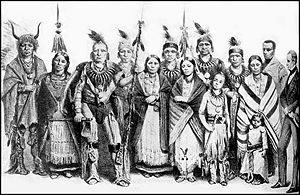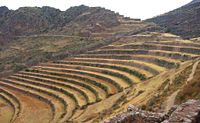Primitive culture

The term primitive culture was used in older anthropology texts and discussions of the 17th, 18th and 19th century by European explorers and anthropologists to describe indigenous societies, particularly those of North, South America the Caribbean, Africa and Oceania. While the term is no longer used due to its inherent racist and ethnocentric undertones, anthropologists nonetheless recognize these groups of people in its categorization of the differing evolution of human societies.
Etymology
Early anthropologists believed that the cultures encountered in the new world preserved in a state unchanged since "stone age" paleolithic or neolithic times, and hence labeled them as primitive, which comes from the Latin "prīmitīvus" meaning "first of its kind".[1].
Early Anthropological Thought
Early contact with indigenous tribes of people by the first European explorers created a serious interest in the minds of both the public at large and the scholars of Europe about other societies and cultures. Early anthropologists and sociologists used the term Primitive Culture to describe the newly contacted societies that often lacked major signs of economic development or modernity, such as the lack of a written language or advanced technology. Often times these societies also had limited and isolated populations. Some of these scholars and academics held that these types of societies were essentially inferior to those of Europe, hence the label of primitive. For those societies that did in fact have technology and large societies, such as the Aztecs, some Europeans held that they were nonetheless primitive because they were not Christians. Such beliefs were often the justification used for conquering and converting native societies all over the globe.
Negative views of primitive cultures, while often prevalent, were not always the majority of thinking. Other early sociologists and other writers portrayed primitive cultures as noble—noble savages—and believed that their lack of technology and less integrated economies made them ideal examples of the correct human lifestyle. Among these thinkers were Jean-Jacques Rousseau, who is most frequently associated with the idea of the noble savage based on his Discourse on Inequality[2] and Karl Polanyi, who in The Great Transformation praised the economic organization of primitive societies as less destructive than the market economy.[3]
Both positive and negative standpoints were based primarily in the assumption that contemporary indigenous peoples or their cultures were comparable to the earliest humans or their cultures. Some people still make this assumption. Modern anthropological thought does incorporate a evolutionary model of human society, applicable to both humanity in general and to specific societies. However, the notions of barbarism and noble savages has for the most part been left out of academics. The romantic notion of previous cultures is still sometimes expressed in main stream areas, such as literature and popular culture, but as political climates have moved more towards an equal stand point, cultures once thought of as primitive are often looked upon with respect. This is not to say that racism or ethnocentrism for the ancestors and even now gone societies has died all together; in comparison with Victorian Era thought however, it has become increasingly less prevalent.
Different Types of Primitive Cultures
Nomadic
Nomadic people, also known as nomads, are communities of people that move from one place to another, rather than settling down in one location. Nomadism is distinguished from migration, which involves a major and permanent move from one location to another. Nomads, on the other hand, move periodically or cyclically, in conjunction with climate or animal migration patterns, usually returning to their original location at various times Many cultures were traditionally nomadic, some of the most famous being the Eurasian Avars who roamed much of Eurasia due to war and environments unable to provide stable, permanent societies; the Hephthalites who developed no formalized written language, lived across central Asia in small bands, and practiced polyandry; the Wu Hu, which were composed of various non-Chinese steppe tribes during the period from the Han Dynasty (206 B.C.E. -22 C.E.) to the Northern Dynasties, and the Plain Indians of North America, whom often lived in small bands and roamed the vast wilderness of the American continent.
Unlike nomads who move due to fluctuations in nature, Peripatetic nomadism involves those who move from place to place offering a specific trade. Peripatetic nomads are commonly found in industrialized nations. One large and well known group of peripatetic nomads are the Roma, often referred to as "gypsies", although the term, like primitive and noble savage, is seen as antiquated and insulting. The Roma are a nomadic ethnic group who are found in Southern and Eastern Europe, Western Asia, Latin America, the southern part of the United States, and the Middle East. Roma people, particularly in Eastern Europe, often live in depressed squatter communities, with very high unemployment, while only some are fully integrated in the society. However, in some cases—notably the Kalderash clan in Romania, who work as traditional coppersmiths—they have prospered. Although some Roma still embrace a nomadic lifestyle, much of their migration is actually forced, as most communities do not accept Roma settlements.
Hunter-Gathers
Hunter-gatherers were foragers, dependent upon the natural availability of food. Consequently, they were relatively mobile, moving on as their food supplies become exhausted. This nomadic lifestyle, in which all possessions must be carried, lead hunter-gatherers to rely on materials available in the wild to construct simple shelters. There was rarely any elaborate building of permanent housing or development of cities in such societies. Their mobile lifestyle generally meant that there was no possibility of storing surplus food and thus the society remained at a subsistence level.[4]
The nature of the available food supplies lead hunter-gatherer societies to develop different specializations. Some hunted big game, or trapped animals, while others fished in lakes, rivers, or along the coast. An older term found in Scandinavian countries is hunter-trapper instead of "gatherer," signifying their use of complex trap systems involving holes in the ground to catch elks, reindeer, etc. Hunter-gatherer societies tended to have very low population densities. Only a limited number of people could congregate without quickly exhausting the local food supplies. Nomadic hunter-gatherer societies usually had non-hierarchical social structures, unlike higher-order horticultural, pastoral, and industrial societies. The group usually consisted of a small number of family units, often related, comprising a tribe. Typically, men were responsible for hunting and women for gathering.
The Bushmen and Pygmies of Africa and the Innu of eastern Québec and Labrador, Canada are some examples of contemporary hunter-gather societies.
Horticultural Societies
See History of agriculture Article
Horticultural societies actually grew out of hunter-gather groups, that had developed a sunstainable enough supply of food and resources to create sedintary communities, at first cultivating a variety of crops on a small scale around their dwellings or in specialized plots visited occasionally during migrations from one area to the next. The main distinction between horticultural societies and some of oldest civilizations in history that developed agriculture (such as the Sumerians and Egyptians) is that horticultural societies were often small bands directly transitioning from hunter-gather status and did not develop large cities and hierarchies.
In Mesoamerica, starting around the Archaic period of Mesoamerican chronology (8000-2000 B.C.E.), many of the hunter gatherer micro-bands in the region began to cultivate wild plants. The cultivation of these plants probably started out as creating known areas of fall back, or starvation foods, near seasonal camps, that the band could rely on when hunting was bad, or when there was a drought. By creating these known areas of plant food, it would have been easier for the band to be in the right place, at the right time, to collect them. Eventually, a subsistence pattern, based on plant cultivation, supplemented with small game hunting, became much more reliable, efficient, and generated a larger yield. As cultivation became more focused, many plant species became domesticated. These plants were no longer able to reproduce on their own, and many of their physical traits were being modified by human farmers. The most famous of these, and the most important to Mesoamerican agriculture, is maize. Maize is storable for long periods of time, it can be ground into flour, and it easily turns into surplus for future use. Maize became vital to the survival of the people of Mesoamerica, and that is reflected in their origin, myths, artwork, and rituals.
In pre-contact North America the semi-sedentary horticultural communities of the Eastern Woodlands grew maize, squash and sunflower while also practicing hunting and gathering.
Pastoralist Societies
Nomadic pastoralism based societies used a form of agriculture where livestock (such as cattle, sheep, goats, and camels), were taken to different locations in order to find fresh pastures. It was, and still is, commonly practiced in regions with little arable land. Nomadic pastoralism seems to have developed as a part of the secondary products revolution proposed by Andrew Sherratt.[5] Sherratt suggested that early use of domestic animals for primary carcass products (meat) was broadened to include exploitation for renewable "secondary" products (milk and its associated dairy products, wool and other animal hair, hides and consequently leather, manure for fuel and fertilizer, traction, and riding/pack transport).[6] Many of these innovations first appeared in the Near East during the fourth millennium B.C.E. and spread to Europe and the rest of Asia soon afterwards. Historically, nomadic herder lifestyles led to warrior based cultures, fearsome enemies of settled people.
The famous Reindeer herders of Russia, the Sami, the Bakhtiari of Iran, the Bedouin and Fulani of Africa are all famous examples of contemporary pastoralist societies,
Notes
- ↑ "primitive." Dictionary.com Unabridged (v 1.1). Random House, Inc. 11 Nov. 2008. <Dictionary.com http://dictionary.reference.com/browse/primitive>.
- ↑ Damrosch, Leo. Jean-Jacques Rousseau: Restless Genius (Mariner Books 2007, ISBN 0618872027
- ↑ Stanfield, J. Ron. The Economic Thought of Karl Polanyi: Lives and Livelihood (Macmillan, 1986 ISBN 0333396294)
- ↑ Panter-Brick, Catherine, Robert H. Layton, and Peter Rowley-Conwy (eds). 2003. Hunter-Gatherers: An Interdisciplinary Perspective. Cambridge University Press. ISBN 0521776724
- ↑ Andrew Sherratt, "Plough and pastoralism: aspects of the secondary products revolution" Pattern of the Past: Studies in the Honour of David Clarke. (Cambridge University Press, 1981, ISBN 978-0521227636)
- ↑ Andrew Sherratt, "Plough and pastoralism: aspects of the secondary products revolution" Pattern of the Past: Studies in the Honour of David Clarke. (Cambridge University Press, 1981, ISBN 978-0521227636)
ReferencesISBN links support NWE through referral fees
- Stanley Diamond, In Search of the Primitive, Transaction Publishers,U.S. 1987, ISBN 087855582X
- Adam Kuper, The Reinvention of Primitive Society. Transformations of a Myth , Taylor & Francis Ltd. 2005, ISBN 0415357616
- Farb, Peter (1968). Man's Rise to Civilization As Shown by the Indians of North America from Primeval Times to the Coming of the Industrial State. New York, NY: E. P. Dutton.
Credits
New World Encyclopedia writers and editors rewrote and completed the Wikipedia article in accordance with New World Encyclopedia standards. This article abides by terms of the Creative Commons CC-by-sa 3.0 License (CC-by-sa), which may be used and disseminated with proper attribution. Credit is due under the terms of this license that can reference both the New World Encyclopedia contributors and the selfless volunteer contributors of the Wikimedia Foundation. To cite this article click here for a list of acceptable citing formats.The history of earlier contributions by wikipedians is accessible to researchers here:
The history of this article since it was imported to New World Encyclopedia:
Note: Some restrictions may apply to use of individual images which are separately licensed.


